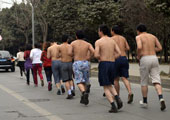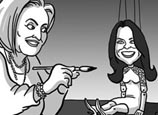
 |
| (File Photo) |
Key Words:TCM; theraphy;gua sha
Related Reading:
>>China to speed up traditional medicine standardization
>>French 'daifu' Paillard obsessed by Chinese medicine and therapy
>>Senegalese girl studies Chinese medicine
Gua sha is an easy-to-acquire and highly useful Chinese therapy, and has been widely practiced in China since ancient times. Ancient Chinese often scrape the skin with a dull-edged household instrument such as a silver coin, soup spoon, and tender bamboo board dipped in water, liquor, or sesame oil. As long as red rash-like spots occur, patients’conditions will soon improve. However, there are some common misconceptions about gua sha.
The first misconception is that gua sha can break blood vessels and cause body injuries.
Many people refuse to receive gua sha treatment because they think it will damage their blood vessels and cause venous congestion. "Sha" seeps out of blood vessels without damaging them. When gua sha stops, “sha” also stops seeping out. Studies have found that "sha" seeps out through capillaries, the thinnest of all types of blood vessels. Capillaries have only one layer of endothelial cells, and are permeable.
Gua sha can force blood containing toxin to seep out of permeable capillaries, and form red spots on the skin. This process, if conducted moderately, can improve local microcirculation instead of causing tissue damage.
The second misconception is that gua sha is just a healing technique.
Many people turn to gua sha only when they feel pain. In fact, a healthy person will not have red spots on the skin after receiving gua sha treatment. Only people with sub-health conditions and patients will have red spots on the skin after receiving gua sha treatment. The position, color, and form of "sha" vary according to the area, degree, and nature of microcirculatory disturbances. Gua sha can show hypoxia and stasis on the skin in the form of "sha," and help doctors understand patients’ conditions intuitively. Therefore, gua sha is also a diagnostic technique.
The third misconception is that only patients can receive gua sha treatment.
Microcirculatory disturbances are early symptoms of sub-health and illnesses, and gua sha can promote blood circulation, activate cells, force toxin out, and improve microcirculation.
The fourth misconception is that gua sha is painful.
Gua sha does not cause pain as long as it is conducted according to the following principles. First, people who receive gua sha treatment should choose a comfortable body position, and relax their muscle. Second, the angle between the gua sha tool and the skin should be less than 45 degrees. The narrower the angle is, and the slower the treatment is carried out, the less painful it is. Third, rigid pressing should be avoided, and the skin should be scraped using moderate strength. Fourth, wrists, elbows, and shoulder joints should all be used in gua sha treatment. Fifth, the skin should be scraped in various ways. Sixth, the same body area should not be scraped several times. Seventh, the time of gua sha treatment should be limited to 30 minutes.
The fifth misconception is that any random tool can be used to conduct gua sha treatment.
Professional gua sha tools include the scraping board and lubricant. The scraping board should be made of materials that cause no side effects, including buffalo horns, jade, and bian stones. Cream lubricant should be used when the face is scraped, and liquid lubricant for other parts of the body, so the skin can be effectively protected, and the efficacy of gua sha treatment can be improved.
The sixth misconception is that any person can receive gua sha treatment.
No therapy can treat all illnesses, and gua sha is no exception. People with uncertain or acute disease and critically ill patients should go to a doctor or receive gua sha treatment under the guidance of a doctor. People who feel fatigued, have an empty stomach, have just sweated or bled heavily, or have liver and kidney failure must not receive gua sha treatment. Gua sha cannot be used in treating thrombocytopenia, allergic purpura, or leukemia. The following body parts should not receive gua sha treatment: unhealed bone fractures, malignant tumors, and the abdomen of a woman on her period or a pregnant woman.
Read the Chinese version: 刮痧六大误区
Source:Life Times, author: Zhang Xiuqin.
















 Police dog on duty for first time in Chengdu
Police dog on duty for first time in Chengdu


![]()
